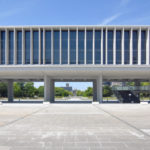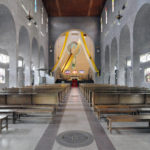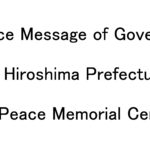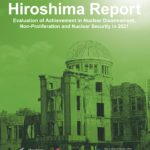Column: Mission of the Hiroshima Peace Memorial Museum
Introduction
After the blast, there was a man who went about gathering rocks and tiles among the burnt ruins with a bag on his back. His name was Shogo Nagaoka, and he went on to become the first director of the Hiroshima Peace Memorial Museum. In 1948, the City of Hiroshima temporary commissioned Nagaoka (then a part-time instructor for the Geological and Mining Science Department of the Hiroshima University of Literature and Science) to investigate the effects of the atomic bomb. In 1949, the “A-bomb Reference Material Display Room” was set up at the Chuo Community Hall in Moto-machi. At first, it was merely a display of tiles and stones placed upon desks and chairs. Then, the “Atomic Bomb Memorial Hall” was established alongside the Chuo Community Hall. Though the facility was small, the panoramic model of post-bomb Hiroshima even drew dignitaries from overseas. While working to rebuild, the people of Hiroshima kept records of their experiences of the bombing and chose a way to preserve such memories.
1 How the Museum Was Built
The Hiroshima Peace Memorial Museum opened in the Peace Memorial Park 10 years after the bombing, in August 1955. The bomb caused catastrophic damage, but Hiroshima quickly moved into lively discussions about reconstruction, drawing up the “Hiroshima Reconstruction City Planning” the very next year in 1946. However, the progress of the project was not always smooth due to financial difficulties.
What broke through these obstacles was a special law that applied to a specific local public entity, based on Article 95 of the Japanese Constitution; this law is called, the Hiroshima Peace Memorial City Construction Law. Backed by this law, which passed unanimously in both houses of the Diet in May 1949, the development of Peace Memorial Park began. The City of Hiroshima held a competition to design the Peace Memorial Park; and in August of that year, the plan proposed by Kenzo Tange’s group (an assistant professor at the University of Tokyo) won the first prize from among 145 entries. This plan aligned the A-bomb Dome, an arch, and a display hall so that one could see the A-bomb Dome through the arch from the Peace Boulevard.
In February 1951, construction began on the Atomic Bombed Relics Display Hall (today’s Main Building of the Hiroshima Peace Memorial Museum) that Tange designed; and a piloti-style building rose “amid the ruins.” Progress, however, was slow due to funding difficulties. Construction work was suspended many times in every year, and it took five years to complete the building. The museum finally opened in August 1955, and (as previously mentioned) Shogo Nagaoka became the first director. At the time, the exhibition rooms were surrounded by glass walls―with sunlight pouring in and no air conditioning. And even though the items on display were limited to the materials and photos collected by Director Nagaoka and by the A-bomb Material Collection Support Association (later known as the A-bomb Material Preservation Society), the museum had over 110,000 visitors in its first year. The admission fee was 20 yen for adults (13 years old or older) and 10 yen for children (under 13).
2 What to Convey and How
As the exhibits were improved focusing on real materials, the number of visitors increased annually; and that number exceeded 500,000 in the 1961 fiscal year. In 1964, the English audio guide (explaining the exhibits) was introduced for visitors from overseas. In the following year, audio guides were made in Japanese and many other languages (as of March 2014, it was available in 17 languages including Chinese, Korean, and French). In 1970, “dialogue notebooks” for visitors to write down their thoughts and feelings were put in place. In the 1971 fiscal year, the museum had over one million visitors for the first time. In 1972, the admission fee was changed to 50 yen for adults and 30 yen for children, and it remains so to this day.
The next year, in 1973, the museum saw its first major renovation. At this time, measures to prevent the deterioration of the materials were implemented―including blocking sunlight entering the exhibition hall. Additionally, at around the same time, materials that had been collected by the U.S. military during the occupation were returned to Japan. The exhibit changed significantly based on these new materials.
Before the 50th anniversary of the bombing, the museum underwent a great change. In 1991, the museum’s second large-scale renovation was conducted, introducing a large video apparatus. Then in June 1994, the East Building opened, and the museum came to consist of two buildings. The permanent exhibit in the new East Building introduced the history of Hiroshima before the bombing, the circumstances surrounding the bombing, the reconstruction of the city, the current conditions of the nuclear world, and Hiroshima’s commitment to peace. Additionally, there are exhibition rooms in the basement floor, a hall and meeting rooms (in which A-bomb survivors can share their experiences with visitors). With these facilities, the museum’s function as a “place for learning peace” was enhanced. Furthermore, A-bomb exhibitions began to be conducted in earnest both in Japan and abroad.
3 Passing on an Experience of Human Suffering
In July 2006, the Peace Memorial Museum became the first postwar building to be designated as an important cultural property of Japan. The City of Hiroshima asked for citizens’ opinions and, based on the deliberations by a review committee composed of academics and survivors, established a basic plan in July 2010 for renewing the exhibition at the Hiroshima Peace Memorial Museum. This plan included a change of the order of the exhibits and renovations needed to accommodate such a change as well as an overall update to the entire exhibition. As A-bomb survivors began aging, and the number of people who had not experienced the war had exceeded that of those who had, the basic plan included a strong awareness of the museum’s mission to convey the reality of the atomic bombing. The basic plan of 2010 configured the permanent exhibits into four zones: the “Introductory Exhibit,” “The Reality of the Atomic Bombing,” “The Danger of Nuclear Weapons,” and “Hiroshima’s Progress.” The “Reality of the Atomic Bombing,” being the core of the exhibits, looks at the tragedy of the atomic bombing from a human (the survivors’) perspective and more than ever aims to convey the inhumanity of the atomic bombing, the devastating damage it caused, and the suffering of the bereaved families and survivors―by focusing on the actual references, such as personal belongings left by the victims, and photos and films that show the damage of the time.
4 The Hiroshima National Peace Memorial Hall for the Atomic Bomb Victims
In August 2002, the Hiroshima National Peace Memorial Hall for the Atomic Bomb Victims opened to the east of the Cenotaph for the A-bomb Victims. The inscription at the entrance to this Memorial Hall reads, “Mourning the lives lost in the atomic bombing, we pledge to convey the truth of this tragedy throughout Japan and the world, pass it on to the future, learn the lessons of history, and build a peaceful world free from nuclear weapons.” This Hall was established in Hiroshima (and Nagasaki) by the national government to remember and mourn the sacred sacrifice of the atomic bomb victims, in order to pass down the stories of its horrors to the future generations. The Memorial Hall has extensive facilities for passing down the A-bomb testimonies, including the victims’ information area with the names and portraits of the deceased; a library in which A-bomb memoirs, testimonial videos and photographs are made open to the public; a special exhibition area; and the Hall of Remembrance.
The Peace Memorial Museum and the National Peace Memorial Hall complement the functions of each other and continue to deepen their cooperation.
(Shoji Oseto and Hitoshi Nagai)
References
Hiroshima Toshi Seikatsu Kenkyukai (Ed.). Hiroshima Hibaku Yonju Nenshi, Toshi no Fukko (Reconstruction of HIROSHIMA, Pictorial History of Forty Years since Atomic Bombing). Division of Culture, Planning and Coordination Bureau, City of Hiroshima.1985.
Hiroshima Peace Memorial Museum (Ed.). Sanju Nen no Ayumi (30 Year History of the Hiroshima Peace Memorial Museum). Hiroshima Peace Memorial Museum.1987.
Hibaku Goju Nen Kinenshi Henshu Kenkyukai (Ed.). Hibaku Goju Shunen Zusetsu Sengo Hiroshima Shishi: Machi to Kurashi no Goju Nen (An Illustrated History of Postwar Hiroshima: Fifty Years of Life after the Atomic Bomb). Hiroshima Municipal Archives, General Affairs Bureau, City of Hiroshima. 1996.
Hiroshima Peace Culture Foundation (Ed.). Hiroshima Heiwa Bunka Senta Niju Nenshi – Senta no Ayumi (20-Year History of the Hiroshima Peace Culture Foundation). Hiroshima Peace Culture Foundation. 1997.
Genbaku Shibotsusya Tsuito Heiwa Kinen Kan Kaisetsu Junbi Kento Kai (Ed.). Genbaku Shibotsusha Tsuito Heiwa Kinenkan Kaisetsu Junbi Kentokai Saishu Hokoku (Peace Memorial Hall for Atomic Bomb Victims: Opening Preparation Study Commission’s Final Report). Planning Division, Health and Medical Service Bureau, Ministry of Health and Welfare. 1998.
Hiroshima Peace Memorial Museum (Ed.). Hibaku Rokuju Shunen Kinen Jigyo – Hiroshima Heiwa Kinen Shiryokan Kaikan Goju Shunen Kikakuten: Haikyo no Naka ni Tachiagaru – Heiwa Kinen Shiryokan to Hiroshima no Ayumi (60th Anniversary Project: Commemorative Exhibition for the 50th Anniversary of the Hiroshima Peace Memorial Museum―Rising from the Ruins – the Peace Memorial Museum and Hiroshima). (An exhibition catalog). Hiroshima Peace Memorial Museum. 2005.
City Planning Division, Urban Development Bureau, City of Hiroshima (Ed.). Hiroshima Heiwa Kinen Toshi Kensetsuho–Rinen o Mirai e (Hiroshima Peace Memorial City Construction Law – Bringing its Philosophy into the Future). City Planning Division, Urban Development Bureau, City of Hiroshima. 2008.
City Planning Division, Urban Development Bureau, City of Hiroshima (Ed.). Hiroshima no Fukko (Reconstruction of Hiroshima). City Planning Division, Urban Development Bureau, City of Hiroshima. 2005.
Hiroshima Heiwa Kinen Shiryokan Koshin Keikaku (Hiroshima Peace Memorial Museum Renewal Plan). Peace Promotion Division, International Peace Promotion Department, Planning and General Affairs Bureau, City of Hiroshima. 2007.
Hiroshima Heiwa Kinen Shiryokan Tenji Seibi to Kihon Keikaku (Hiroshima Peace Memorial Museum Basic Exhibition Development Plan). City of Hiroshima. 2010.
Hiroshima National Peace Memorial Hall for the Atomic Bomb Victims Website.
Tags associated with this article








